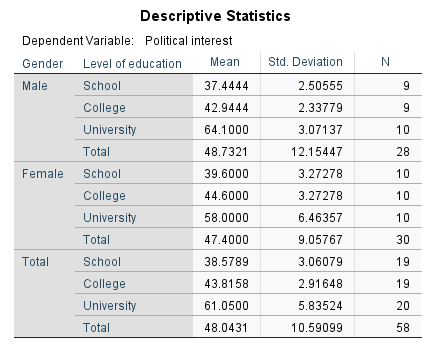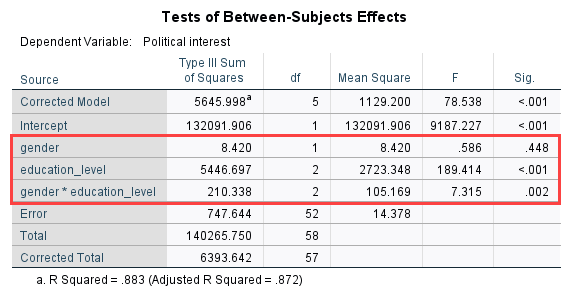

The resultingīasic Tables dialog box that appears is shown above. On the menu that appears, and then "Basic Tables…". (a) click on "Statistics" on the SPSS controls, and then click on "Custom Tables" Product of the degrees of freedom for each independent variable in the interaction.īy itself, the ANOVA output doesn't tell us that much: we need someĭescriptive statistics to get the complete picture of what is going on.To obtain There is a general rule for determining the DF for an interaction: it is the – 1 as there are 3 subjects in a group, the DF are 2. The degrees of freedom for the variance within group is the number of subjects Of levels of that independent variable – 1. Note that the DF for each main effect is (as in the one-way case) the number a comparison of the between group variability to the within group variability. The three effects, the F ratio is the mean square treatment divided by the MSe Once again each MS is just the SS divided by its DF. ("age", "sex") and also for the interaction ("age by We now have three treatment mean squares, one for each main effect It is just the average of the variances for each of your Note: The "within+residual" refers to the within-group variability,Īnd the mean square (MS) associated with it is sometimes called "mean squareĮrror", or MSe. (f) Now click on "OK", and the results of our ANOVA appear in the "output" This case, our minimum and maximum values are "1" (for males), and "2" (for (e) Repeat steps (c) and (d) for the independent variable of "sex". Leaving you with the previous one on the screen. "young") and the highest is "3" (for "old"), so type these numbers into the



#TWO WAYS ANOVA SPSS CODE#
In this case, our lowest code is "1" (for SPSS wants to know is the lowest and highest numbers used asĬodes for this independent variable. (d) Click on "define range": a dialog box will pop up, asking for a "minimum"Īnd a "maximum". As soon as you do this, the "define range" buttonīelow the box will change from faded to bold, and question-marks will appear Highlight "age" and use the lower arrow-button to move it into theīox labelled "Factor(s)". Of it - young (coded with a 1), middle-aged (coded with a 2) and old (coded One independent variable is "age", and we have three levels (c) We now need to tell SPSS about each of the independent variables in We have now told SPSS where our data, our Click on the upper arrow-button to move "rt" into In this case, we've only got one to choose from: "rt", the column containing (b) Highlight the dependent variable on which you want to perform the ANOVA. Much of the following procedure is similar to that used for the one-way independent-measures A dialog box will now appear, shown below. ThenĬlick on "ANOVA models" on the menu that appears. (a) Click on "Statistics" on the SPSS controls at the top of the screen. The completed data-set might look like this. Use any numbers you like: for example, "1" for All we have to do is add another column of code-numbers to tell Now we are going to look for the effects of another I.V. There, we were looking at the effects on reaction-time of just one independent Let's return to the data we used in the handout for the one-way ANOVA. Using SPSS: Two-way Between-Subjects ANOVA


 0 kommentar(er)
0 kommentar(er)
